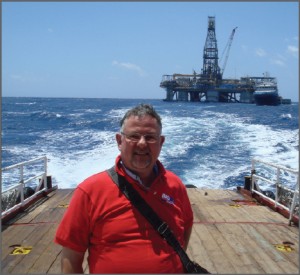Perspectives: Gert-Jan Windhorst, Noble Corp
Industry must not take HSE success for granted
By Linda Hsieh, managing editor

Having been born and raised in the Netherlands in a family of sailors, it wasn’t particularly hard for Gert-Jan Windhorst to decide that he wanted to major in nautical science at the Hogeschool Rotterdam. Then, after getting his bachelor’s degree in 1977, he started traveling the world offshore, first on refrigerator ships that stored food products, then on barges and dredgers conducting dredging operations around Europe, Latin America and Alaska’s Beaufort Sea.
Those two jobs kept him out on the seas on and off for nearly a decade. It wasn’t until 1986 that he decided to leave the dredging industry, mostly because he had been promoted to captain, which meant that he got to do less of the actual dredging work and much more paperwork. “The captain didn’t get to do the interesting parts of the job anymore,” he recalled.
Mr Windhorst later built his experiences in the agro-chemical and biotechnology industries, developing and managing HSE and quality assurance systems, performing risk assessments and implementing security policies and procedures. By 1996, he had joined Noble Drilling (then Neddrill) as manager of HSE&Q.
Upon joining the drilling industry in 1996, he was impressed by the safety improvements that had been made compared with what he had seen while working as a dredger. “There was a big difference compared with the early ’80s. We had started working more like the process industry with good standards and guidelines. We were doing things to be safer, not just to be faster,” he said.
Yet he knew there was more to be done. Since Mr Windhorst joined Noble, he has helped to develop and implement systems that have reduced the company’s incidents and near-misses by approximately 60% and reduced work-related health and safety risks for platform workers by approximately 40%. Other projects have included developing a patented method of workplace assessment and an integrated “corrective action management” system.
“There’s a lot of behavioral things that still need to be addressed. Why do people do a task the right way 98% of the time but won’t do it the other 2%?” he said. In fact, nearly all safety incidents can be traced back to human behavior. “Is it that they’re tired in those 2% of the time? Is it that they were thinking about something else? We don’t know, but that’s the behavior we need to influence.”
Noble is tackling behavior-related incidents through three pillars – leadership, culture and systems, Mr Windhorst said. Each pillar must be strong before safety can be improved. “It’s the 80/20 rule. You fix 80% of the problems with 20% of the effort, and the last 20% will take 80% of the effort. We’ve been working on that last 20% for some time.”
Mr Windhorst has also contributed significantly to collaborative industry projects on HSE, one of which was the IADC HSE Case Guidelines in the late ’90s. The guidelines are used by drilling contractors to centralize their safety cases across various countries, streamlining what were once duplicative efforts made from one country to another. “It was a good project,” he said. “Having an organization like IADC that will take on projects like these is great. I look at a lot of other globally active industries that don’t have an organization like IADC, and they don’t understand what a blessing it is. You can share your knowledge, and you can speak with one voice.”
Another collaborative industry project that Mr Windhorst is currently developing with a Dutch working group is a standard bridging document. It will aim to align the safety processes of the drilling contractor, the operator and third-party service companies.
“Those processes should be aligned so it’s communicated as one process. That would give employees a better understanding of what they’re doing and prevent mistakes.” He hopes the group can have the document in place in the Netherlands by next year, then eventually get it adopted in other countries.
Despite the vast improvements that the industry has made with HSE over the past decades, Mr Windhorst cautions that we must not take this success for granted: “If you don’t continue to work on health, safety and environment, things will go down again. It’s not a given to stay at this level. We can’t underestimate the risks and work that still must be done. New generations that are starting in our business – they also have to ask questions like ‘Why?’ ‘What if?’ and have the ability to say no.”




